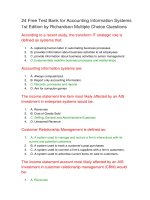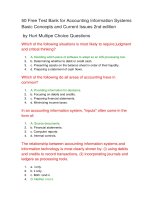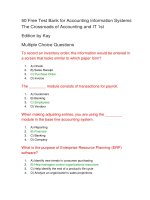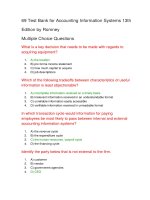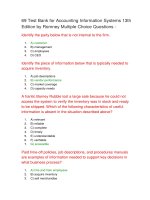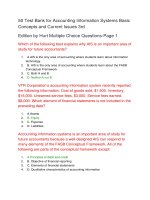87 test bank for auditing and assurance services 4th edition
Bạn đang xem bản rút gọn của tài liệu. Xem và tải ngay bản đầy đủ của tài liệu tại đây (123.57 KB, 23 trang )
87 Test Bank for Auditing and Assurance Services 4th
Edition
True - False Questions
The concept "professional skepticism" requires that auditors assume
management is dishonest and should not be trusted.
1.
True
2.
False
The AICPA licenses CPAs to practice in the United States.
1.
True
2.
False
The objective of internal auditing is to assist members of an organization to
effectively perform their obligations.
1.
True
2.
False
Financial decision makers demand reliable information that is provided by
accountants.
1.
True
2.
False
Independent auditors are employees of the client.
1.
True
2.
False
Four conditions that create demand for reliable information are complexity,
remoteness, timeliness, and consequences.
1.
True
2.
False
Assurance service is the systematic process of objectively obtaining and
evaluating evidence.
1.
True
2.
False
Evidence consists of assertions about economic actions and events.
1.
True
2.
False
Expanded scope governmental auditing includes economy and efficiency and
program results audits.
1.
True
2.
False
The ASB balance audit objective related to valuation or accuracy is to
determine whether proper values have been assigned to assets, liabilities,
equities, revenues, and expenses.
1.
True
2.
False
Professional skepticism is an auditor's tendency not to believe anyone.
1.
True
2.
False
The PCAOB audit objective related to the completeness assertion is to
establish evidence that assets, liabilities, and equities actually exist.
1.
True
2.
False
Internal auditors perform only operational audits.
1.
True
2.
False
Assurance services are independent professional services that improve the
quality of information or its context for decision makers.
1.
True
2.
False
The purpose of obtaining and evaluating evidence is to ascertain the degree
of correspondence between the assertions and established criteria.
1.
True
2.
False
The AICPA Statement on Auditing Standards defines auditing more broadly
than the AAA definition of auditing.
1.
True
2.
False
The lending of credibility to financial information is known as certification.
1.
True
2.
False
Government auditors perform both financial and performance audits.
1.
True
2.
False
For independent auditors of financial statements in the United States,
established criteria largely consist of the generally accepted accounting
principles (GAAP).
1.
True
2.
False
Financial decision makers obtain their accounting information from lenders of
funds.
1.
True
2.
False
Multiple Choice Questions
The underlying conditions that create demand by users for reliable
information include all of the following, except:
1.
A. Transactions are numerous and complex.
2.
B. Users lack professional skepticism.
3.
C. Users are separated from accounting records by distance and time.
4.
D. Financial decisions are important to investors and users.
5.
E. Decisions are time-sensitive.
In order to be considered as external auditors with respect to government
agencies, GAO auditors must be
1.
A. Organizationally independent.
2.
B. Empowered as the accounting and auditing agency by the U.S. Congress.
3.
C. Funded by the federal government.
4.
D. Guided by standards similar to GAAS.
The four basic requirements for becoming a CPA in most states are
1.
A. Education, the CPA Examination, experience, and substantial equivalency.
2.
B. The CPA Examination, experience, continuing professional education, and a state
certificate.
3.
C. Continuing professional education, the CPA Examination, experience, and an
AICPA certificate.
4.
D. Education, the CPA Examination, experience, and a state certificate.
The auditor's judgment concerning the overall fairness of the presentation of
financial position, results of operations, and cash flows is applied within the
framework of
1.
A. Quality control.
2.
B. Generally accepted auditing standards, which include the concept of materiality.
3.
C. The auditor's evaluation of the audited company's internal control.
4.
D. The applicable financial reporting framework (i.e., GAAP in the United States).
The audit objective that all balances include items owned by the client is
related most closely to which one of the ASB balance assertions?
1.
A. Existence
2.
B. Rights and obligations
3.
C. Completeness
4.
D. Valuation
The risk an entity will fail to meet its objectives is referred to as
1.
A. Business risk.
2.
B. Information risk.
3.
C. Assurance risk.
4.
D. Audit risk.
The process of a CPA obtaining a certificate and license in a state other than
the state in which the CPA's certificate was originally obtained is referred to
as
1.
A. Substantial equivalency.
2.
B. Quid pro quo.
3.
C. Relicensing.
4.
D. Re-examination.
The PCAOB assertions made by management in financial statements do not
include
1.
A. Existence.
2.
B. Compliance.
3.
C. Completeness.
4.
D. Presentation.
Because of the risk of material misstatement, an audit of financial statements
in accordance with generally accepted auditing standards should be planned
and performed with an attitude of
1.
A. Objective judgment.
2.
B. Independent integrity.
3.
C. Professional skepticism.
4.
D. Impartial conservatism.
The probability that the information circulated by a company will be false or
misleading is referred to as
1.
A. Business risk.
2.
B. Information risk.
3.
C. Assurance risk.
4.
D. Audit risk.
The audit objective that footnotes in the financial statements should be clear
and expressed such that the information is easily conveyed to the readers of
the financial statements is related most closely with which of the ASB
presentation and disclosure assertions?
1.
A. Occurrence
2.
B. Rights and obligations
3.
C. Comprehensibility
4.
D. Understandability
Cutoff tests designed to detect credit sales made before the end of the year
that have been recorded in the subsequent year provide assurance about the
PCAOB assertion of
1.
A. Presentation.
2.
B. Completeness.
3.
C. Rights.
4.
D. Existence.
The engineering department at Omni Company built a piece of equipment in
the company's own shop for use in the company's operations. The auditor
reviewed all work orders that were capitalized as part of the equipment costs.
Which of the following is the ASB transaction assertion most closely related
to the auditor's testing?
1.
A. Occurrence
2.
B. Completeness
3.
C. Accuracy
4.
D. Classification
Which of the following is not included in The American Accounting
Association (AAA) definition of auditing?
1.
A. Potential conflict of interest.
2.
B. Systematic process.
3.
C. Assertions about economic actions.
4.
D. Established criteria.
The audit objective that all the transactions and accounts presented in the
financial statements represent real assets, liabilities, revenues, and expenses
is related most closely to which of the PCAOB assertions?
1.
A. Existence or occurrence
2.
B. Rights and obligations
3.
C. Completeness
4.
D. Presentation and disclosure
Which of the following is not a major element of assurance services?
1.
A. Independence
2.
B. Improving the quality of information
3.
C. Improving profitability of the client
4.
D. Improving the context of information
According to the American Accounting Association (AAA), the definition of
auditing includes the following statement
1.
A. an independent appraisal function established within an organization to examine
and evaluate its activities.
2.
B. a process of reducing to a socially acceptable level the information risk to users of
financial statements.
3.
C. an expression of opinion on the fairness of financial statements.
4.
D. a systematic process of objectively obtaining and evaluating evidence regarding
assertions about economic actions and events.
The audit objective that all transactions and accounts that should be
presented in the financial statements are in fact included is related to which of
the PCAOB assertions?
1.
A. Existence
2.
B. Rights and obligations
3.
C. Completeness
4.
D. Valuation
What is the term used to identify the risk that the client's financial statements
may be materially false and misleading?
1.
A. Business risk.
2.
B. Information risk.
3.
C. Client risk.
4.
D. Risk assessment.
Which of the following is not a recommendation usually made following the
completion of an operational audit?
1.
A. Economic and efficient use of resources.
2.
B. Effective achievement of business objectives.
3.
C. Attesting to the fairness of the financial statements.
4.
D. Compliance with company policies.
The audit objective that all transactions are recorded in the proper period is
related most closely to which of the Audit Standards Board (ASB) transaction
assertions?
1.
A. Occurrence
2.
B. Completeness
3.
C. Cutoff
4.
D. Accuracy
The definition of performance audits does not include
1.
A. economy audits.
2.
B. efficiency audits.
3.
C. financial audits.
4.
D. program audits.
The audit objective that all transactions are recorded in the proper account is
related most closely to which one of the ASB transaction assertions?
1.
A. Occurrence
2.
B. Completeness
3.
C. Accuracy
4.
D. Classification
The accounting, auditing, and investigating agency of the U.S. Congress,
headed by the U.S. Comptroller General is known as
1.
A. The Federal Bureau of Investigation (FBI).
2.
B. The U.S. General Accounting Office (GAO).
3.
C. The Internal Revenue Service (IRS).
4.
D. The United States Legislative Auditors (USLA).
The Sarbanes-Oxley Act of 2002 requires that the key company officials certify
the financial statements. Certification means that the company CEO and CFO
must sign a statement indicating:
1.
A. They have read the financial statements.
2.
B. They are not aware of any false or misleading statements (or any key omitted
disclosures).
3.
C. They believe that the financial statements present an accurate picture of the
company's financial condition.
4.
D. All of the above.
In performing an attestation engagement, a CPA typically
1.
A. Supplies litigation support services.
2.
B. Assesses control risk at a low level.
3.
C. Expresses a conclusion on an assertion about some type of subject matter.
4.
D. Provides management consulting advice.
The goal of operational auditing is to
1.
A. Help managers discharge their management responsibilities and improve
profitability.
2.
B. Evaluate compliance with specific laws and regulations.
3.
C. Reduce to a socially acceptable level the information risk to users of financial
statements.
4.
D. Express an opinion on the fairness of financial statements.
Which of the following is an underlying condition that in part creates the
demand by users for reliable information?
1.
A. Economic transactions that are numerous and complex.
2.
B. Decisions are time-sensitive.
3.
C. Users separated from accounting records by distance and time.
4.
D. Financial decisions that are important to investors and users.
5.
E. All of the above.
The ASB transaction objective that requires the auditor to establish evidence
that all transactions and accounts that should be presented in the financial
statements are included is?
1.
A. Completeness.
2.
B. Existence or occurrence.
3.
C. Rights and obligations.
4.
D. Valuation or allocation.
Which of the following best describes assurance services?
1.
A. Independent professional services that report on the client's financial statements.
2.
B. Independent professional services that improve the quality of information for
decision makers.
3.
C. Independent professional services that report on specific written management
assertions.
4.
D. Independent professional services that improve the operations of the client.
Which of the following is the essential purpose of the audit function?
1.
A. Detection of fraud.
2.
B. Examination of individual transactions to certify as to their validity.
3.
C. Determination of whether the client's financial statement assertions are fairly stated.
4.
D. Assurance of the consistent application of correct accounting procedures.
Assurance services involve all of the following, except
1.
A. Relevance as well as the reliability of information.
2.
B. Nonfinancial information as well as traditional financial statements.
3.
C. Providing absolute rather than reasonable assurance.
4.
D. Electronic databases as well as printed reports.
Which of the following is not an ASB assertion about inventory related to
presentation and disclosure?
1.
A. Inventory is properly classified as a current asset on the balance sheet.
2.
B. Inventory is properly stated at cost on the balance sheet.
3.
C. Major inventory categories and their valuation bases are adequately disclosed in
notes.
4.
D. All of the above are ASB presentation and disclosure assertions about inventory.
The engineering department at Omni Company built a piece of equipment in
the company's own shop for use in the company's operations. When looking
at the ending balance for the fixed asset account the auditor examined all
work orders, purchased materials, labor cost reports, and applied overhead
that were capitalized as part of the equipment costs. Which of the following is
the ASB balance assertion most closely related to the auditor's testing?
1.
A. Existence
2.
B. Completeness
3.
C. Rights and obligations
4.
D. Valuation
CPA certificates and licenses to practice are issued by the
1.
A. AICPA.
2.
B. States or territories.
3.
C. AICPA Examinations Division.
4.
D. GAO.
Inquiries of warehouse personnel concerning possible obsolete or slow
moving inventory items provide assurance about the ASB balance assertion
of
1.
A. Completeness.
2.
B. Existence.
3.
C. Presentation.
4.
D. Valuation.
5.
E. Rights and obligations.
Which of the following is not an underlying condition that creates demand by
users for reliable financial information?
1.
A. Remoteness
2.
B. Vagueness
3.
C. Consequences
4.
D. Complexity
Which of the following best describes the primary role and responsibility of
independent external auditor?
1.
A. Produce a company's annual financial statements and notes.
2.
B. Express an opinion on the fairness of a company's annual financial statements and
footnotes.
3.
C. Provide business consulting advice to audit clients.
4.
D. Obtain an understanding of the client's internal control structure and give
management a report about control problems and deficiencies.
Which of the following is not a role of the AICPA?
1.
A. Refine the body of professional knowledge, regulate membership admissions, and
police conduct of members.
2.
B. Prepare and grade the uniform CPA examination.
3.
C. License the practices of CPAs in the various states.
4.
D. Issue public statements on practice standards.
Inquiries of warehouse personnel concerning possible obsolete or slow
moving inventory items provide assurance about the PCAOB assertion of
1.
A. Completeness.
2.
B. Existence.
3.
C. Presentation.
4.
D. Valuation.
5.
E. Rights and obligations.
The audit objective that all balances include all items that should be recorded
in that account is related most closely to which one of the ASB balance
assertions?
1.
A. Existence
2.
B. Rights and obligations
3.
C. Completeness
4.
D. Valuation
Which of the following is an example of a regulatory auditor?
1.
A. Internal auditors
2.
B. Big 4 auditors
3.
C. U.S. Internal Revenue Service auditors
4.
D. Operational auditors
Which of the following best describes the main reason independent auditors
report on management's financial statements?
1.
A. Management fraud may exist, and it is likely to be detected by independent auditors.
2.
B. The management that prepares the statements and the persons who use the
statements may have conflicting interests.
3.
C. Misstated account balances may be corrected as the result of the independent audit
work.
4.
D. The management that prepares the statements may have a poorly designed system
of internal control.
The study of business operations for the purpose of making
recommendations about the efficient use of resources, effective achievement
of business objectives, and compliance with company policies is referred to
as
1.
A. Environmental auditing.
2.
B. Financial auditing.
3.
C. Compliance auditing.
4.
D. Operational auditing.
Which of the following is not a PCAOB assertion about inventory related to
presentation and disclosure?
1.
A. Inventory is properly classified as a current asset on the balance sheet.
2.
B. Inventory is properly stated at its cost on the balance sheet.
3.
C. Major inventory categories and their valuation bases are adequately disclosed in
notes.
4.
D. All of the above are PCAOB presentation and disclosure assertions about inventory.
To be proficient as an auditor, a person must first be able to accomplish
which of these tasks in a decision-making process?
1.
A. Identify audit evidence relevant to the verification of assertions management makes
in its unaudited financial statements and notes.
2.
B. Formulate evidence-gathering procedures (audit plan) designed to obtain sufficient,
competent evidence about assertions management makes in financial statements and
notes.
3.
C. Recognize the financial assertions made in management's financial statements and
footnotes.
4.
D. Evaluate the evidence produced by the performance of procedures and decide
whether management's assertions conform to generally accepted accounting principles
and reality.
An attestation engagement is one in which a CPA is engaged to
1.
A. Issue, or does issue, a report on subject matter or an assertion about the subject
matter that is the responsibility of another party.
2.
B. Provide tax advice or prepare a tax return based on financial information the CPA
has not audited or reviewed.
3.
C. Testify as an expert witness in accounting, auditing or tax matters, given certain
stipulated facts.
4.
D. Assemble prospective financial statements based on the assumptions of the entity's
management without expressing any assurance.
Free Text Questions
The audit process involves obtaining and evaluating
_____________________________.
Answer Given
evidence
Examples of _____________________________
_____________________________ are (1) economy and efficiency audits and
(2) program audits.
Answer Given
performance audits
_____________________________ governmental auditing goes beyond an
audit of financial reports and compliance with laws and regulations to include
_____________________________ and _____________________________ and
_____________________________ _____________________________ audits.
Answer Given
Expanded-scope, economy, efficiency, program results
The purpose of obtaining and evaluating evidence is to ascertain the degree
of correspondence between the _____________________________ and
_____________________________.
Answer Given
assertions, established criteria
The ASB transaction objective related to _____________________________ is
to determine whether proper values have been assigned to all financial
transactions.
Answer Given
accuracy
Define assurance, attestation, and auditing in the context of "lending
credibility."
Answer Given
Assurance is the "lending of credibility" to information. Attestation is the "lending of
credibility" to assertions made by a third party. Auditing is the "lending of credibility" to
financial statements.
_____________________________ _____________________________ is an
auditor's tendency not to believe management assertions.
Answer Given
Professional skepticism
What is information risk? What is business risk?
Answer Given
Information risk is the risk that financial statements will be materially false or
misleading. Business risk is the risk an entity will fail to meet its objectives.
The four basic requirements for becoming a CPA are
_____________________________, _____________________________,
_____________________________, and _____________________________.
Answer Given
education, examination, experience, state certificate and license
The objective of the ordinary examination of financial statements by the
independent auditor is the expression of a(n)
_____________________________ on the _____________________________ of
financial statements.
Answer Given
opinion, fairness
The _____________________________ is the accounting, auditing, and
investigating agency of the U.S. Congress.
Answer Given
GAO
A _____________________________ consists of writing up the financial
statements from a client's books and records.
Answer Given
compilation
Through the process of _____________________________, after becoming a
CPA licensed in one state, a person can obtain a CPA certificate and license
in another state.
Answer Given
Substantial equivalency
_____________________________ refers to recognizing assets and liabilities
as of proper date and accounting for revenue, expense, and other
transactions in the proper period.
Answer Given
Cutoff
_____________________________ _____________________________ is the
study of business operations for the purpose of making recommendations to
managers on how to improve profitability.
Answer Given
Operational auditing
What are the four basic requirements for becoming a CPA?
Answer Given
Education, the CPA Examination, experience, and a state certificate.
The risk that the information disseminated by a company will be materially
false or misleading is called _____________________________
_____________________________.
Answer Given
information risk
The ASB balance objective related to _____________________________ is to
establish with evidence that all transactions and accounts that should be
presented in the financial statements are included.
Answer Given
completeness
What are the differences between the American Accounting Association and
AICPA definitions and objectives of auditing?
Answer Given
The AAA definition is broad and general enough to encompass independent, internal,
and governmental auditing. The AICPA has not defined auditing but its statement on
objectives of financial audits restricts auditing to independent CPA's audit of the
traditional financial statements and their footnotes. The AICPA SAS also offers guides
to report on internal control, letters to underwriters, and special reports.
What is operational auditing and by whom is it performed?
Answer Given
Operational auditing is the evaluation of business operations for various purposes.
Operational auditing includes: (1) testing for compliance with laws and regulations and
company policies and procedures, (2) evaluating the effectiveness of operations in
achieving goals and objectives, and (3) evaluating the efficiency and economy of
operations. Operational audits are normally performed by internal auditors. However,
operational audits also may be conducted by independent CPA firms as part of their
management advisory services.
